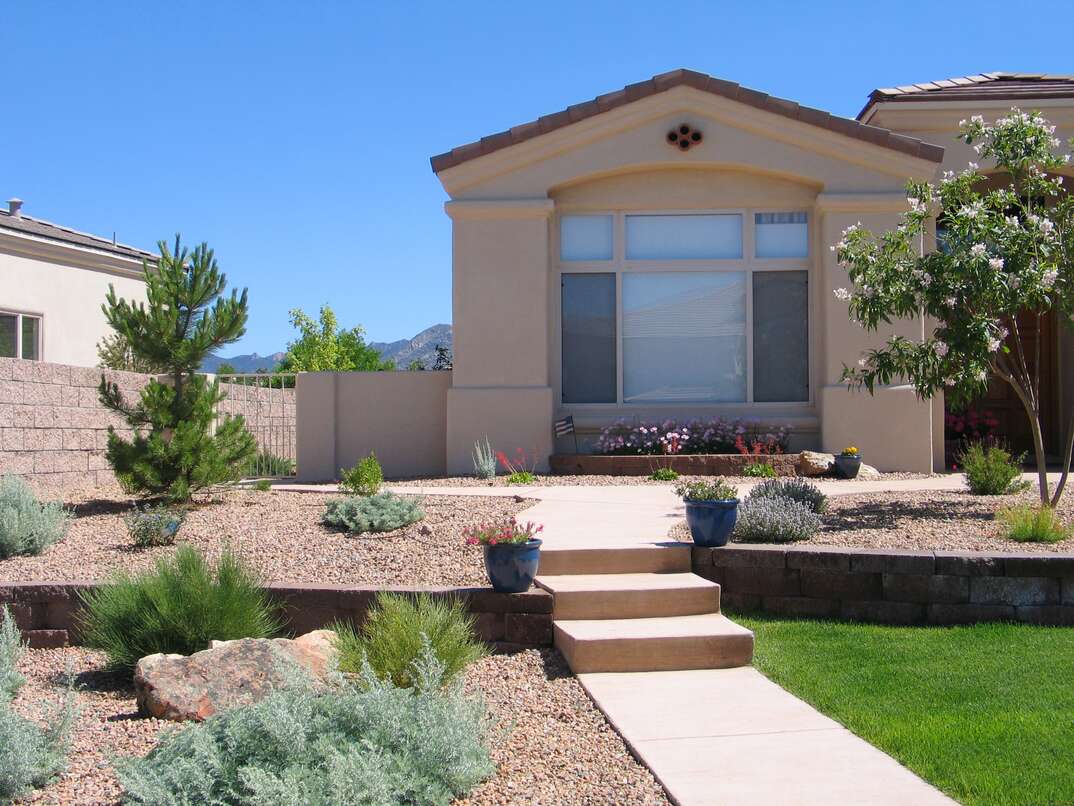What Are the 7 Principles of Xeriscaping?

A landscaped garden can provide great views from your window, encourage you to use your yard and even increase the value of your home. However, it can be difficult to achieve a great cottage garden or lush lawn in an area with little rainfall.
In desert and drought-prone regions, xeriscaping can help you create a beautiful, eco-friendly garden in a dry environment without using a lot of water.
What Is Xeriscaping?
Xeriscaping is a form of landscaping that requires little to no irrigation. The combination of the right plants, smart irrigation and appropriate hard landscaping allows xeriscape gardens to thrive with water that’s provided naturally through rainfall and other sources. Xeriscape landscaping often uses plants that are native to an area. It’s generally found in drier areas of the country, especially the Southwest.
A xeriscape garden is better for the environment as it conserves water and provides native vegetation that helps local birds and wildlife thrive. Although the initial cost of xeriscaping can be high, it can save you money on your water bill in the long term. With lower maintenance needs, a xeriscaped garden can also save you time.
The principles of xeriscaping were created by Denver Water in 1981. They consist of seven simple concepts that you can use to plan an appealing, low-water yard:
1. Plan and Design for Water Conservation
In a xeriscape design, water conservation needs to be at the center of any planning. Consider your own wants and needs, as well as the limitations of your space and the climate. A well-designed landscape lets you make decisions based on your garden’s circumstances, such as size, shade and existing structures. With the proper design, you’re more likely to create a flourishing garden.
2. Improve the Soil
Good soil is essential for any garden to thrive, as it conserves water and provides nutrients to plants. As xeriscaping emphasizes the use of native plants, it may be possible to do a lot of your landscaping with what you already have. However, building can damage soil structures, and previous homeowners may have brought in soil from other areas, so you should analyze what you have and look at improving it through organic matter if needed.
3. Limit Turf Area
Many grasses, especially those used in suburban lawns, are thirsty plants that require frequent watering to stay lush. Although it’s not impossible to have a grassy lawn in a xeriscaped garden, you should consider limiting the size. Think about how much grass you need, especially if you don’t have children or pets playing outside. You should also consider planting a lawn that requires less water.
4. Irrigate Efficiently
Although xeriscaping uses minimal water, it’s still likely that your plants will need supplemental water, especially as they’re being established. Smart irrigation systems can help you ensure water goes to where it’s needed and isn’t wasted. Sprinklers that send mists of water into the air don’t work well in hot climates as the water evaporates before plants can absorb it. Drip irrigation is generally a better choice as it waters the base of the plant where it’s needed.
5. Select Appropriate Plants and Create Hydrozones
When choosing your plants, look for options that suit your climate. Cacti and succulents are popular choices, as are native plants that are already adapted to the weather. Create hydrozones by choosing and grouping together plants with similar water needs. This saves you time when watering and can help you make smart irrigation choices. You can also use your landscaping to help build hydrozones. For example, plants with higher moisture needs can go at the bottom of a slope where rain pools or in the shade where evaporation is slower.
6. Mulch to Reduce Evaporation
Xeriscape landscaping uses mulch to trap water close to the soil. Mulch has the added benefits of reducing weeds and stopping erosion. Inorganic mulches like stones or gravel are popular in xeriscaping for the look they provide, but they can increase soil heat. Organic mulches like bark chips and wood shavings can add nutrients to the soil and keep it cool. Understand what your plants need before making a choice. As you often want plants to spread in a xeriscape design to give a filled-in look, landscape fabric is not usually used in these gardens.
7. Maintain Your Xeriscape
Although xeriscaped yards are low maintenance, that doesn’t mean they’re no maintenance. Do regular, seasonal maintenance to keep your xeriscape plants healthy and looking their best. This can include pruning, fertilizing and controlling pests. It’s also good to check your watering systems regularly so your garden is getting the moisture it needs.
Elocal Editorial Content is for educational and entertainment purposes only. Editorial Content should not be used as a substitute for advice from a licensed professional in your state reviewing your issue. Systems, equipment, issues and circumstances vary. Follow the manufacturer's safety precautions. The opinions, beliefs and viewpoints expressed by the eLocal Editorial Team and other third-party content providers do not necessarily reflect the opinions, beliefs and viewpoints of eLocal or its affiliate companies. Use of the Blog is subject to the
Website Terms and Conditions.The eLocal Editorial Team operates independently of eLocal USA's marketing and sales decisions.



